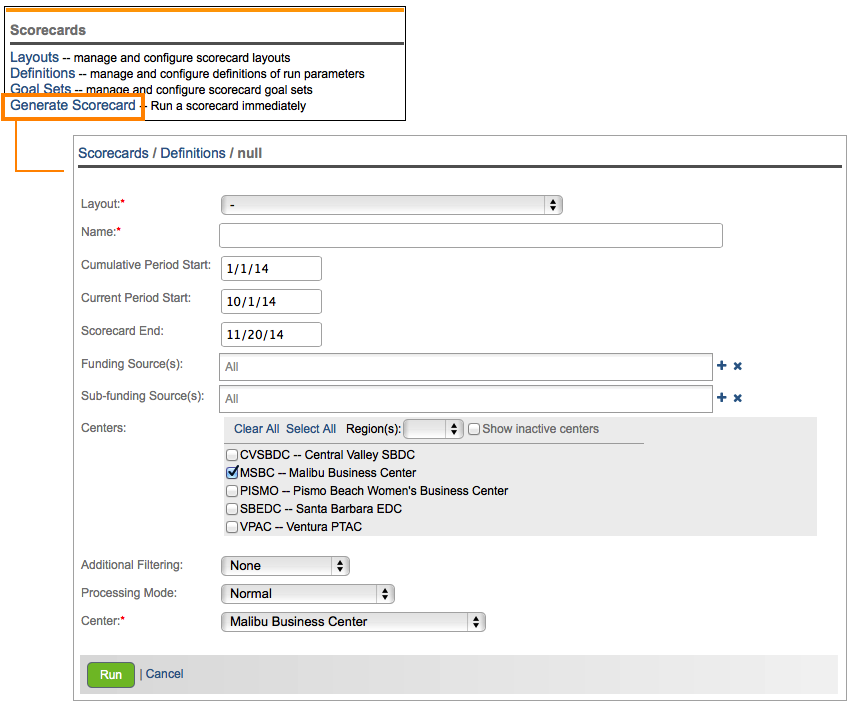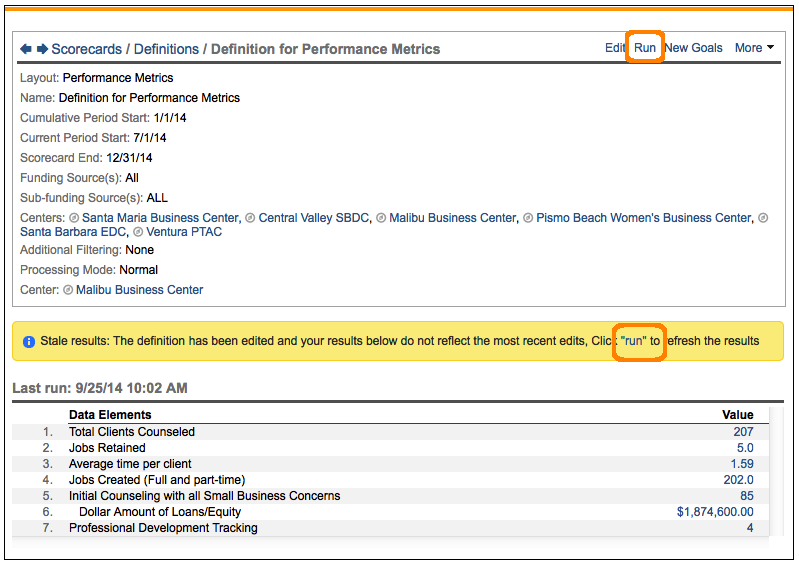How do I generate a scorecard?
You cannot run a scorecard until you have established its run parameters. These run parameters include date range(s); record filters such as funding source and center; and processing mode. A set of run parameters can either be entered on the fly for a one-time generation of a particular scorecard, or it can be saved as a scorecard definition record and used repeatedly to run a scorecard.
In this FAQ, we'll cover the various ways in which you can initiate scorecard generation:
- Generate Scorecard
- Running scorecards from a layout
- Running scorecards from definition records
- Running scorecards from goal records
- Scheduling scorecards
Generate Scorecard
To run a scorecard and not save your run parameters, you can use the Manage|Scorecards|Generate Scorecard command, as shown in the next graphic. Generating a scorecard on the fly allows you to do some test runs without saving your definition parameters.

Enter the information as appropriate for your scorecard run:
- In order to run a scorecard, you must first choose which scorecard Layout you want to run. From the drop down, either choose one of the system-defined scorecards or choose a custom created scorecard.
- Enter a Name for this run. A default name will automatically appear.
- In the Cumulative Period Start Date field, enter the starting date of your reporting period (this is typically the first day of your current fiscal year).
- If the scorecard layout that you are creating a definition record for supports both a cumulative and current period column (creators of custom scorecards have the option of turning support for both columns off), the Current Period Start Date field is available for editing and you should enter the start date of the currenct period you are reporting on.
- In the Scorecard End Date field, enter the end date of the period you are reporting on.
- By default, the Funding Source(s) field displays "All" funding sources. If you would like to limit your scorecard to records from certain selected funding sources then you should specify the funding sources accordingly. When you restrict a scorecard's ouput to one or more funding sources, it has the following impact:
- Only client activity records (e.g. milestone, award, investment, etc.) and conference records that display one of the funding sources chosen are considered.
- For custom scorecards, only client records that display one of the funding sources chosen are considered. For system scorecards, this may not always hold true; it depends solely upon the specifications provided to us by your funding agency. You can find the exact calculations for built-in scorecards in their corresponding "Understanding the <scorecard name>" help files.
- By default, the Sub-funding Source(s) field defaults to "All." If you would like to restrict the inclusion of records according to any optional sub-funding assigned (e.g. you only want to report upon work done under the Jobs Act), then you can specify the specific sub-funding sources you are interested in. In most cases you will want to leave the default set to "All."
- Choose the Centers' whose records you want to include in your scorecard run. By default, only active centers will be shown. Restricting a scorecard's output to one or more centers has the following impact:
- Only client activity records (e.g. milestone, award, investment, etc.) and conference records belonging to one of the chosen centers are considered.
- For custom scorecards, only client records belonging to one one of the chosen centers are considered. For system scorecards, this may not always hold true; it depends solely upon the specifications provided to us by your funding agency. You can find the exact calculations for built-in scorecards in their corresponding "Understanding the <scorecard name>" help files.
- From the Additional Filtering settings, you can restrict the scorecard's output to a saved client filter or a single counselor. Both of these filters have a dramatic impact on the scorecard's output that is not always easily understood so be sure you understand the ramifications before applying either filter:
- When you restrict a scorecard's output to a client filter, it has the following impact:
- Only client activity records (e.g. milestone, award, investment, etc.) that are associated with those particular client records are considered. For example, if you were to filter the scorecard on a saved filter that contained only inactive clients, only activity from inactive clients would be calculated.
- Only training event records whose attendee lists contain at least one client from the filter (marked as "Attended?") are considered.
- For custom scorecards, only client records contained in the filter are considered. For system scorecards, this may not always hold true; it depends solely upon the specifications provided to us by your funding agency. You can find the exact calculations for built-in scorecards in their corresponding "Understanding the <scorecard name>" help files.
- When you restrict a scorecards output to a single counselor, it has the following impact:
- Only client activity records (e.g. milestone, award, investment, etc.) that are assigned to the counselor are considered.
- Only conference records that have the counselor listed as the instructor are considered.
- For custom scorecards, only client records assigned to the counselor are considered. For system scorecards, this may not always hold true; it depends solely upon the specifications provided to us by your funding agency. You can find the exact calculations for built-in scorecards in their corresponding "Understanding the <scorecard name>" help files.
- From the Processing Mode field's drop-down menu, you can specify any special processing you would like done during scorecard generation:
- Selecting one of the "Breakdown by..." options produces a scorecard with one column per center, region, month, quarter, or year—depending of course upon the breakdown option chosen.
- Because of the resources required to run a breakdown scorecard, we don't recommend including more than 12 columns of data.
- Please note that goals cannot be created for breakdown scorecards.
- Selecting the "Include audit information" option generates output that includes an audit trail of all records that contributed to each line item.
- Keep in mind that an audit trail can also be achieved by processing the scorecard normally and then clicking any line item in the generated scorecard to see all records included in that line item's total.
- The Restrict to only reportable records? field is always checked by default! This checkbox should only be unchecked by system administrators in rare cases when you want to include non-reportable activity. In fact, it can only be unchecked by administrators. This checkbox should be used with extreme caution since most scorecards are designed to only provide reportable data, however, this option does allow you, for example, to run a scorecard to determine the total number of cancelled events you have had this year, or how many administrative sessions have been conducted with your clients.
Keep in mind that this checkbox governs the entire scorecard for which this definition is used, which means it may also pick up other unintended non-reportable activity. If you create a scorecard which includes a mixture of line items - some requiring only reportable data and some including non-reportable data, then you will need to use the "Reportable?" filter on those line items that need to be restricted. For example, here is a scorecard that includes two line items:

The first line item is looking for all cancelled events. By default all cancelled events are non-reportable. Therefore, to run this scorecard we need to uncheck the Restrict to only reportable records? field on the definition record. However, for the second line item we don't want to include the non-reportable records, so we have to add a "Reportable = Yes" filter to this second line item calculation. This filter is only required if/when the Restrict to only reportable records? checkbox is unchecked.
Note: This may also be a good time to point out that scorecards will include data from clients that have been marked for deletion. Until a client is permanently deleted from the system, their counseling, milestone and capital funding activity will be included in the scorecard.
Note: And, it is also worth noting that stakeholders are always, by default, excluded from all scorecard calculations.
- The Center field, at the bottom of the definition record, merely identifies the center where this definition is being created. It has no impact on the output.
- Click Run to run your scorecard per the definitions set forth.
Note: This may also be a good time to point out that scorecards will include data from clients that have been marked for deletion. Until a client is permanently deleted from the system, their counseling, milestone and capital funding activity will be included in the scorecard.
Running Scorecards from a Layout
The second way to run a scorecard 'on the fly' is to run it from the layout record. When you run a scorecard from the layout record, then it is assumed that you don't want to save this definition for future use unless you uncheck the "Run once and discard this definition?" checkbox. If you are planning on saving the definition then make sure you give your definition a name that makes it easy to identify later on. Keep in mind that by default you won't save your definition record created from a layout record.
To generate a scorecard from the Layout record, click on the appropriate layout that you want to run and click the "Run" command at the top of the screen. You will be asked to complete the definition record parameters as discussed above. Upon saving your new definition, click "Run" from the Definition record to see your results.
Running Scorecards from Definition Records
As shown in the following graphic, scorecards can be generated from their associated pre-saved definition records.

In fact, as shown above, there may even be two "Run" links presented on the screen. The "Run" link at the top of the screen is always available, but the "Run" link in the yellow ribbon will appear when Neoserra detects that the definition is out of date.
Running Scorecards from Goal Records
As shown in the following graphic, scorecards can also be generated from their associated goal records. When generating a scorecard from a goal record, you see not only the data in the Neoserra database, but also a comparison of this current data against set goals.

Scheduling Scorecards
As with reports, scorecards can be scheduled to run on a recurring basis, with the generated output delivered via e-mail. When you schedule a scorecard, you are technically scheduling one of its associated definition or goal records.
Want more? Browse our extensive list of Neoserra FAQs.
